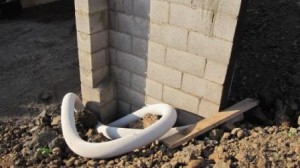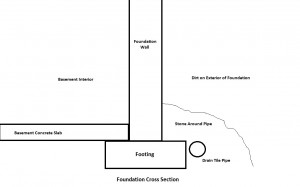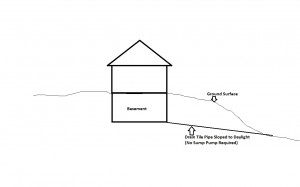Foundation Drainage, The Major Quality Components
0 Comments | Posted by armchairbuilder in Build Your Own Home, Quality Check
One question I’m often asked as a builder is…“What’s the proper setup for a quality foundation drainage system for a home?” Whether you’re building a new home or repairing your existing place, there are a few key items that should be in place to prevent problems. Things like stone placement, footing drain tile and filter membranes are often part of a quality system. Believe it or not, in some rare instances foundation drainage is not necessary. Let’s take a look at when it’s necessary to install, the building code requirements, and the major quality components needed to prevent problems.
When Foundation Drainage is Required
Per most building codes, foundation drainage is required around all concrete or masonry foundations that retain earth and enclose habitable or usable space that’s located below grade. There is one exception to this requirement however. According to the 2012 International Residential Code, A drainage system is not required when the foundation is installed on well-drained ground or sand-gravel mixture soils. So how do you determine if the soil at your home is one of these? The Unified Soil Classification System of course. Once you determine the type of soil you have, you consult the Unified Soil Classification System to determine whether your lot has well-drained soil.
As a builder, I can tell you I would never build a home with a basement without installing some form of foundation drainage. Why? Because most types of systems designed to collect foundation water just don’t cost all that much. It’s not worth the risk you take to save a few hundred dollars on your new home. Putting in a foundation drainage system when building a new home is exponentially cheaper than installing one after the home is built.
Foundation Drainage System Components
The most important component of any foundation drainage system is that which collects the water around the lower perimeter of the foundation wall and transports it to either a sump pit or to daylight. One of the most common methods of collection and transport is the traditional drain tile. Modern day drain tile consists of a pipe (perforated or with holes), stone surrounding the pipe, and a filter fabric or paper to prevent silt particles from the soil from getting into the pipe and clogging it.
Per the 2012 International Residential Code, the foundation drainage system is required to…
- be installed at or below the area to be protected
- discharge by gravity or mechanical means to an approved drainage system
- have gravel that extend past the outside edge of the footing at least a foot and extend above the footing at least 6 inches
- have an approved filter fabric or paper covering the gravel/stone
- have a pipe that rests on a minimum of 2 inches of washed gravel or crushed rock (if a pipe is used)
- have a minimum of 4 inches gravel or crushed stone under basement slab
- contain a 6 mil vapor retarder (plastic sheeting) placed over the stone before pouring the basement floor
- have a sump installed to drain the stone layer under the basement floor and the footings
Can you describe how this works in layman’s terms? Basically, the drainage pipe (or other approved system) is installed around the entire perimeter of the foundation to be protected. Stone is installed around the pipe to protect the pipe and to help provide a porous layer to facilitate the movement of water. A filter fabric or other paper is used to prevent the silt from the soil above from washing down through the stone and into the pipe. The water collects in the pipe and runs to either a discharge pipe by gravity to daylight (see illustration) or to the sump crock.
The stone below the basement or crawl space floor plays a vital role in the foundation drainage system. It allows any ground water that gets up under the floor to migrate through the porous stone to the sump crock. Don’t forget, the ground water table rises at times, and can bring water up underneath the basement floor. So the four inch stone layer beneath the floor helps to drain this area.
There are several good Armchair Builder articles covering drain tile and the prevention of basement moisture. The links to these articles are listed below. If you have any questions regarding your existing or new installation, feel free to contact us.
Drain Tile and Your Basement (video)
House Foundation Excavation: High Water Table Issues




